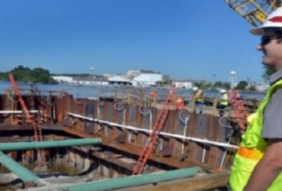
Posted on June 23, 2016
By Mary Landers, savannahnow.com
The U.S. Army Corps of Engineers is moving forward on a critical $100 million mitigation project for harbor deepening, the oxygen injection system. The system must prove viable before inner harbor dredging can proceed.
On Monday, workers from CDM Constructors Inc. (CDM Smith) of Maitland, Fla., and from TIC — The Industrial Co. on Hutchinson Island pumped water from a riverside coffer dam that will be the site of the water intake structure for the system. Site preparation began in January at the site more than two miles upstream of the Talmadge Bridge near International Paper’s wastewater treatment ponds that tinge the air with an acrid odor. By December 2017, five oxygen injection devices, called Speece cones, will be operational here.
Another eight of the devices will be installed at an upriver site on the grounds of Georgia Power’s Plant McIntosh in Effingham County. That site is currently being cleared, said Mike Bringman, a project engineer with the corps.
The corps awarded CDM a $99.6 million contract last year to manage construction of the project.
The two-stories-tall Speece cones, named for the Vanderbilt University engineering professor who invented them, Richard Speece, will be installed to blend oxygen into the water before it’s returned to the river. The extra oxygen is needed to make up for oxygen depletion caused by dredging the river an additional 5 feet to a depth of 47 feet. Speece is a co-founder of ECO2, the company whose product the corps required to be used in the project. The cones themselves make up $22 million of the total cost.
Two Speece cones used in a 2007 demonstration project on the Savannah River are in Indianapolis being refurbished by ECO2 for re-use in the mitigation. The unusual devices were visible from River Street during the demo.
“Because they’re stainless steel conical vessels people probably think they have something to do with brewing (beer),” said the corps’ Scott Weaver, a construction representative.
In reality, all they brew is water with extra oxygen dissolved in it.
A building on each site will house equipment that concentrates oxygen from ambient air to feed into the Speece cones. Pipes will return the super-oxygenated water to the river near its bed in both the front and back river.
The successful operation of the Hutchinson Island dissolved oxygen plant is crucial to harbor deepening. That plant must be complete, operational and shown to be capable of mitigating dissolved oxygen impacts expected from the deepening before dredging the inner harbor can begin. Those terms came from a mediated settlement between environmental groups and South Carolina government agencies on one side and the corps and Georgia Ports Authority on the other.
Although the demonstration project was deemed a success by the Georgia Ports Authority and the corps, others including the U.S. Geological Survey, have expressed skepticism over the use of this technology in a large, dynamic estuary like the lower Savannah River. It’s usually used in smaller projects, such as wastewater treatment ponds.
Source: savannahnow





